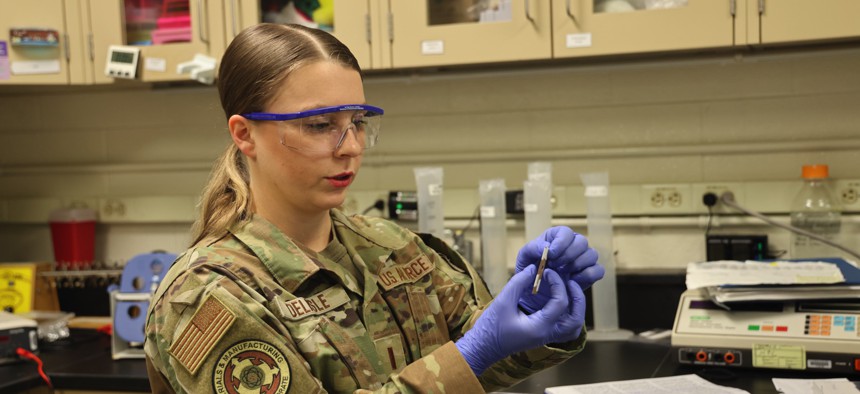
2nd Lt. Evon Delisle, a biomaterials research scientist, tests the strength of muskox hair at the Air Force Research Laboratory's Materials and Manufacturing Directorate, Wright-Patterson Air Force Base, Ohio. U.S. Air Force / Jonathan Taulbee
DARPA seeks AI-powered ‘autonomous scientist’ to help researchers
The agency wants to do for scientists what AI code generators have done for programmers.
DARPA wants an AI-powered “autonomous scientist” that can help human researchers sort through and develop new working theories, and it's offering up to $1 million to companies that can help.
“What we're trying to do is replicate the success that we've seen for automatic code generation,” Alvaro Velasquez, DARPA’s program manager for Foundation Models for Scientific Discovery, told Nextgov/FCW, a Defense One sister publication. “Right now, software engineers and coders enjoy these tools from OpenAI and Microsoft that help automate the generation of code. We would like to come up with a tool that helps automate the process of scientific discovery.”
Ideally, DARPA’s autonomous scientist will be creative and learn to generate unique scientific hypotheses that take into account advanced aspects of experiments — like scaling and trimming costss — as well as providing skeptical reasoning. In its offer, which was released earlier this month, DARPA officials say that the final product should be “at least 10X better in scalability (problem size, data size etc.) and also in time efficiency.”
Velasquez reiterated that the autonomous scientist is a tool to help human researchers in both technical and creative ways.
“This is not meant to replace the human scientist,” he said. “This is meant to act as an aid to sort of automate the process of generating useful hypotheses and such.”
Use cases for DARPA’s intended autonomous scientists are diverse. Some examples include applying the AI tool to research in climate modeling and materials discovery. The domain Velasquez cites in the contract is using the autonomous scientist to aid in protein folding in computational biology experiments.
Proposals should aim not to just train an autonomous scientist to learn the vast data inputs required for advanced generative output, but to extrapolate novel and unique hypotheses to test based on the scientific parameters within various disciplines.
DARPA’s autonomous scientist work is exploratory. Constructing foundational AI models –– large machine learning algorithms trained on large volumes of data that can handle diverse commands –– is a field still in its infancy, Velasquez said. DARPA is overseeing several other AI exploratory efforts, part of the agency’s larger Artificial Intelligence Exploration grant and contract opportunities.
Should the autonomous-scientist effort produce a safe and useful AI tool, the winning foundational models could be used to solve other challenges at DARPA and beyond. Velasquez said that he would love to see it used by other government research institutions, such as the Air Force Research Lab and the Naval Research Lab.
“I would love to see this in every government service lead if we are successful,” he said. “I envision that someday, all scientists will have an autonomous co-scientist helping them along the way.”


